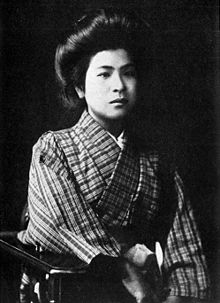Noe Ito
| Itō Noe | |
|---|---|
 |
|
| Born |
January 21, 1895 Fukuoka, Japan |
| Died | September 16, 1923 (aged 28) Tokyo, Japan |
| Spouse(s) | Jun Tsuji |
Noe Itō (伊藤 野枝 Itō Noe?, January 21, 1895 – September 16, 1923) was a Japanese anarchist, social critic, author and feminist.
Itō was born on the island of Kyushu near Fukuoka, Japan on January 21, 1895. At 14 she went to work for the post office; the next year she moved to Tokyo to enter the Ueno Girls' High School.
In the summer of her fifth year at Ueno, under her uncle's management she was married to a man named Fukutaro, agreeing to the marriage because Fukutaro had just returned from America, where she hoped to go. She confided in her sister that when they reached America she would leave him. That never happened, they remained in Japan, and Itō's displeasure deepened when her husband did not support her educational interests—which had been part of the wedding arrangement.
While attending Ueno, Itō formed a friendship with her English teacher, Jun Tsuji. He had been her confidante during her marriage, and he let her stay with him when she was to be sent back home with her husband, which would have disrupted her education. With his support she ended her marriage and continued her education.
In March 1912, Itō graduated from Ueno Girls' High School. She joined the Society (青鞜社 Seitō-sha), producer of the feminist arts-and-culture magazine (青鞜) in 1915, contributing until 1916. In her last year as Editor-in-Chief, she practiced an inclusive attitude towards content; she "opened the pages to extended discussions of abortion, prostitution, and motherhood". Itō wrote social criticism and novels, and translated writings of Emma Goldman (The Tragedy of Woman's Emancipation, etc.).
After graduation, Itō's relationship with Tsuji became romantic and they had two sons, Makoto (born on January 20, 1914) and Ryūji (born on August 10, 1915). They were officially married in 1915. Their relationship lasted about four years before she was captivated by Sakae Ōsugi. Starting in 1916, she lived and worked with Ōsugi, where she continued to rise in the feminist group and showed growing leadership potential.
...
Wikipedia
